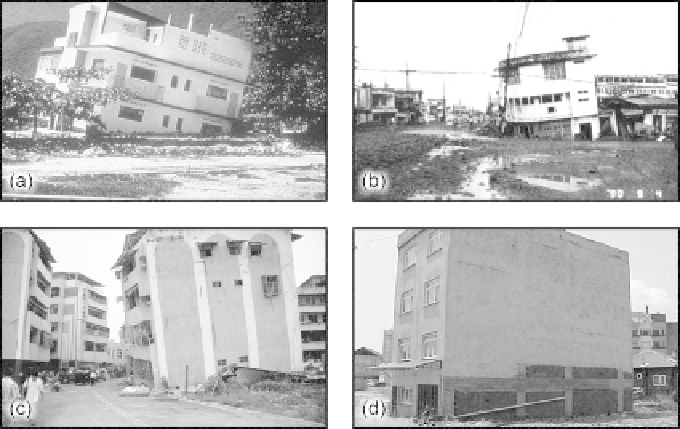Geoscience Reference
In-Depth Information
Fig. 11.1. Liquefaction induced failuresof shallow foundations. (a) Caracas Venezuela,
1967,
M
=
6
.
5, (b) Dagupan, Philippines, 1990,
M
=
7
.
8, (c) Chi-Chi Taiwan, 1999,
M
=
7
.
3, and (d)Adapazari, Turkey, 1999,
M
=
7
.
4
(c) Is it meaningful to seek an acceptable (in terms of bearing capacity and seismic
settlements) allowable bearing pressure, or the range of the corresponding soil and
foundation conditions is too narrow for any practical application, so that soil treat-
ment is always inevitable?
This article deals with the above issues, based on published evidence, as well as on non-
publishedresearchwhichiscurrentlyunderwayattheGeotechnicalDivisionofN.T.U.A.
Toremainfocused,andalsotorespectthelengthlimitsofthepresentation,thearticlewill
address only the case of strip foundations resting upon the free surface of a liquefiable
soil profile with a cohesive (clay) crust. However, many of the concepts, methods and
data presented herein have more general applicability, and can be independently used to
extend the findings of the articletoother foundation and soil profile types.
2. Existing background
2.1. PERFORMANCE-BASED DESIGN REQUIREMENTS
Figure 11.2 presents results from a typical numerical analysis, similar to the ones which
will be presented later in this article, which simulates the static and the seismic loading
of a rigid foundation on liquefiable soil. It may be observed that:
(a) During shaking (part
bc
of the load-settlement curve), the footing settles without
any change of the static load
Q
. Seismic settlements may become considerably

